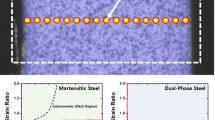Conclusion
The use of Archimedes’ principle in determining the average cross sectional area for odd shaped or flexible specimens is inexpensive, simple, and effective. In the application discussed in this paper, the Young’s modulus of the rubber coating was used in an ANSYS finite element analysis to predict the nip width of the rubber coated roller, i.e., the width of the contact patch between the rubber coated roller and the heating element of a laser printer. These numerical predictions were verified experimentally. Analytical predictions and experimental data were almost identical. If nominal or dial caliper measurements had been used to determine the average cross-sectional area of the specimens we would have had to explain about a fifteen percent discrepancy in our results. We thought that such a simple but accurate approach might be useful for other experimentalists as well.
Similar content being viewed by others
Author information
Authors and Affiliations
Rights and permissions
About this article
Cite this article
Harris, S., Odom, E.M. & Tew, B.W. Using Archimedes’ principle to determine cross-sectional areas. Exp Tech 22, 17–18 (1998). https://doi.org/10.1111/j.1747-1567.1998.tb02316.x
Published:
Issue Date:
DOI: https://doi.org/10.1111/j.1747-1567.1998.tb02316.x




